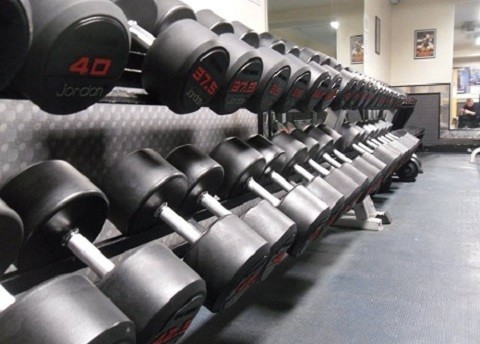
Effective strength training comes in all sorts of formats. Whether it is increasing intensity, increasing reps, lowering the speed of movement, there are many different ways to train your muscles.
Here we take a look at just a few different effective strength training methods.
German Volume Strength Training
The first of these is the decidedly intimidating sounding German Volume Training. This is a method of effective strength training that was devised in the 1970s for the German weightlifting team. Centred around intense, structured strength training sessions, the method was adopted in the 1990s by the Canadian strength coach Charles Poliquin. It is widely acknowledged as one of the most demanding methods of training there is.
German Volume Training involves 10 sets of 10 repetitions (reps), with 60 seconds of rest between sets.
Start with a load that allows you 20 reps. This will feel easy for the first few sets but by the sixth or seventh set, you will be feeling fatigued. There is every chance you will not complete the full 10 sets. When you can complete all 10 sets with 10 reps, then increase the weight at your next session by five per cent.
Recovery is key to effective strength training
For German Volume Training to work, you have to recover fully from each session, so only do one exercise per body part using the 10 x 10 GVT system. And only do two exercises using this method in a single workout. You can complement the 10 x 10 system with a different method of training on the same muscles during the same workout. For example, you may use 10 x 10 squats to train the quads but then use 3 x 10-12 later in your workout on the same muscles.
Alternatively, you could simply do the 10 x 10 on your quads and then use different training methods on your upper body to give your quads a chance o start recovery.
Allow 4-5 days recovery before repeating the 10 x 10 on the same body part.

How to plan your German Volume Training sessions
A pattern could look like this:
Monday – chest and back; Tuesday – legs and abdominals; Wednesday – rest; Thursday – arms and shoulders; Friday – rest; Saturday start all over again.
For exercises that are appropriate for German Volume Training, seek the advice of one of the Kelsey Kerridge trainers working in the Outlooks Gym or Free Weights Gym.
Myotatic Training
Myotatic refers to the stretch reflex that occurs within a muscle. As a muscle lengthens, the nervous systems sends a message telling the muscle to contract. This reflex helps us as we push or pull weights.
If we add a quarter rep between the first and second stage of an exercise, we turn the stretch reflex off and the muscle has to work harder to complete the move.
Add a quarter rep for maximum impact
Take as an example a bench press. In the first stage of the move, you lower the weight until it hovers just above your chest. Now push it a quarter of the way back up, then lower to the chest again. That is your extra quarter rep. Now explode the weight upwards. You have worked the muscle harder and for longer by adding one more element to your lift. Performing the second lift quickly builds explosive power by teaching your muscles to quickly explode from the lengthened position. The quarter rep becomes absolutely brutal, quickly fatiguing muscles and causing serious burn in the targeted area.
Do not do myotatic training on every occasion, limit this type of training to one or two myotatic exercises every week. For multi-joint lifts such as squats, do 4-5 sets of 5 reps. For isolated exercises do 3-4 sets of 10.

Strongman strength training
While Strongman is only a recent addition to gym terminology, the concept has been around for hundreds of years. Today’s Strongman is very similar to the old school style of weight lifting in that it’s about developing real world power.
Strongman has both static strength tests like the deadlift and overhead press but it also involves loading and carrying. A successful strongman (or strongwoman) excels in all aspects of strength. This is not about training one or two isolated muscles, this is about having strength across all areas of your body.
If your goal is to get stronger, fitter, more functional or build more muscle then Strongman training has a vital role to play in your training regime.
Much of Strongman training is about compound movements that can translate into day-to-day functional activities.
Some strongman variations
The log press and viking press are some great alternatives to the standard overhead press with a barbell or dumbells. Also the log will develop your core as you work to get it off the floor and up into the pressing movement.
Also, training isolation movements like bicep curls will help it getting bigger arms for sure, but nothing will build mass like big compound movements such as tyres flips, Yoke, atlas stones and the Log press.
Finally there’s another benefit to strongman training. It’s more functional. Bicep curls will make your arms bigger and stronger, but they’ll become accustomed to a bar. This will leave you more open to injury when you come to use those biceps for something outside of standard curls.
If you implement plenty of strongman training into your routine, you’ll probably notice that your arms will start to get bigger without doing a single curl.

Everyone can benefit from Strongman training
No matter what shape or gender you are, you can benefit from adding some Strongman exercises into your regime. There probably isn’t any other form of weight lifting with as much carry over into the ‘real world’ as strongman training either. Being able to pick up a big awkward rock, or a sandbag and run off with it is going to develop more core strength and functionality than simply lifting a barbell will.
When it comes to Strongman training, do talk to the Kelsey Kerridge staff. They can advise you on what equipment to use, what weight to lift and how many reps are appropriate.







